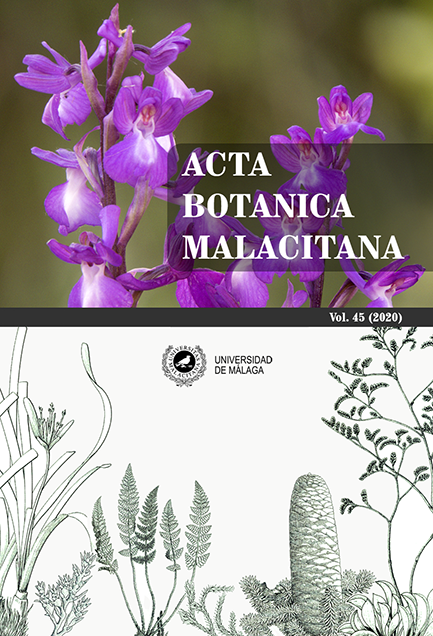Physalis angulata L. (Solanaceae), naturalizada en la Península Ibérica
DOI :
https://doi.org/10.24310/abm.v45i.10543Mots-clés :
Flora alóctona, Solanácea, Physalis, Cataluña, EspañaRésumé
Se informa de la presencia de Physalis angulata como especie naturalizada en cultivos de la Península Ibérica.
Téléchargements
Métriques
Références
Amaral Franco, J. & Pinto da Silva, A.R. (1964). Plantas novas e novas áreas para a flora de Portugal. Agronomia Lusitana, 24(3), 194-195.
Aymerich, P. (2016). Contribució al coneixement de la flora al·lòctona del nord i centre de Catalunya. Orsis, 30, 11-40.
doi: https://doi.org/10.5565/rev/orsis.26
Aymerich, P. & Sáez, L. (2015). Comentaris i precisions previs a la Checklist de la flora de Catalunya (nord-est de la península Ibèrica). Orsis, 29, 1-68.
doi: https://doi.org/10.5565/rev/orsis.18
Aymerich, P. & Sáez, L. (2019). Checklist of the vascular alien flora of Catalonia (northeastern Iberian Peninsula, Spain). Mediterranean Botany, 40(2), 215-242.
doi: https://doi.org/10.5209/mbot.63608
Batard, R. (1970). Sur l’identification d’une espèce de Physalis subspontanée au Portugal. Boletim da Sociedade Broteriana, 44(2), 343-367.
Bean, A.R. (2006). Physalis (Solanaceae) in Australia - nomenclature and identification. Newsletter of Australian Systematic Botany Society, 127, 6-9.
Benítez de Rojas, C. & Magallanes, A. (1998). El género Physalis (Solanaceae) de Venezuela. Acta Botanica Venezuelica, 21(2), 11-42.
Berselli, C., Bonali, F., Labadini, A. & Marenzi, P. (2019). Segnalazioni floristiche per la provincia di Cremona. Pianura. Scienze e storia dell’ambiente padano, 38, 136-143.
Casasayas, T. (1989). La flora al·lòctona de Catalunya. Tesis doctoral. Universitat de Barcelona.
Deanna, R., Larter, M.D., Barboza, G.E. & Simith, S.D. (2019). Repeated evolution of a morphological novelty: a phylogenetic analysis of the inflated fruiting calyx in the Physalidae tribe (Solanaceae). American Journal of Botany, 106(2), 270-279.
doi: https://doi.org/10.1002/ajb2.1242
Electronic Flora of South Australia (2020). Physalis angulata factsheet. Recurso electrónico en www.flora.sa.gov.au. Consulta realizada en 20-10-2020.
Essl, F. & Rabitsch, W. (2002). Neobiota in Österreich. Wien: Umweltbundesamt (Federal Envionment Agency-Austria).
Galasso, G. & al. (2018). An updated checklist of the vascular flora alien to Italy. Plant Biosystems, 152(2), 179-303.
https://doi.org/10.1080/11263504.2018.1441197
Gönen, O., Yildirim, A. & Uygur, F.N.(2000). A new record for the flora of Turkey Physalis angulata L. Turkish Journal of Botany, 24, 299-301.
Hawkes, J.G. (1972). Physalis. In: Tutin T.G. & al. (Eds.), Flora Europaea, vol. 3. (p. 196). Cambridge, UK: Cambridge University Press.
Landrum, L.R., Barber, A., Barron, K., Coburn, F.S., Sanderford, K. & Setaro, D. (2013). Vascular plants of Arizona: Solanaceae part four: Physalis L. and Quincula Raf. Ground Cherry, Tomatillo. Canotia, 9, 1-12.
Milovi?, M., Mitic, B. & Alegro, A. (2010). New neophytes in the flora of Croatia. Natura Croatica, 19(2), 407-431.
Musarella, C.M., Stinca, A., Cano-Ortiz, A., Laface, V.L.A., Petreli, R., Esposito, A. & Spampinato, G. (2020). New data on the alien vascular flora of Calabria (Southern Italy). Annali di Botanica, 10, 55-66.
doi: https://doi.org/10.13133/2239-3129/14838
Ozaslan, C., Farooq, S., Onen, H., Ozcan, S., Bukun, B. & Gunal, H. (2017). Germination biology of two invasive Physalis species and implications for their management in arid and semi-arid regions. Scientific Reports, 7, 16960.
doi: https://doi.org/10.1038/s41598-017-17169-5
Pysek, P., Danihelka, J., Sádlo, J., Chrtek, J., Chytry, M., Jarosík, C., Kaplan, Z., Krahulec, F., Morav-cová, L., Pergl, J., Stajerová, K. & Tichy?, L. (2012). Catalogue of alien plants of the Czech Republic (2nd edition) : checklist update, taxonomic diversity and invasion patterns. Preslia, 84, 155-255.
Rodríguez, J., Deanna, R. & Chiarini, F. (2020). Karyotype asymmetry shapes and diversity within the physaloids (Physalidinae, Physalidae, Solanaceae). Systematics and Biodiversity: en prensa.
doi: https://doi.org/10.1101/2020.04.21.053181
Sanz, M., & Sobrino, E. (2012). Physalis L. In: S. Talavera, M. Arista, M., M.P. Fernández Piedra, M.J. Gallego, P.L. Ortiz, C. Romero Zarco, F.J. Salgueiro, S. Silvestre, S. & A. Quintanar (eds.). Flora iberica. Vol XI. Gentianaceae-Boraginaceae: (pp: 204-209). Madrid: Real Jardín Botánico, CSIC.
Senar, R. & Cardero, S. (2019). Dades de plantes al·lòctones per a l’est de la península Ibèrica. Collectanea Botanica, 38, 009.
https://doi.org/10.3989/collectbot.2019.v38.009
Stace, C. (2010). New flora of the British Isles. Third Edition. Cambridge, UK: Cambridge University Press.
Steševi?, D. & Bubanja, N. (2017). Five new alien species in the flora of Montenegro: Coreopsis tinctoris Nutt., Ipomoea indica (Burm.) Merr., Lupinus x regalis Bergmans, Physalis angulata L. and Solidago canadensis L., and new possible threats to the biodiversity. Natura Croatica, 76(1), 98-102.
https://doi.org/10.1515/botcro-2016-0048
Sullivan, J.R. (2004). The genus Physalis (Solanaceae) in the southeastern United States. Rhodora, 106(928), 305-326.
Tison, J.M. & Foucault, B. (2014). Flora Gallica - Flore de France. Mèze, France: Biotope éditions.
Tison, J.M., Jauzein, P. & Michaud, H. (2014). Flore de la France méditerranéenne continentale. Conservatoire Botanique National Méditerranéen de Porquerolles. Turriers, France : Naturalia Publications.
Travlos, I.S., Economou, G. & Lyberopoulou, S. (2010). The weed Physalis angulata in western Greece. Proceedings of 16th Conference of the Greek Weed Science Society. (p. 41). Karditsa, 1-2 December.
Travlos, I.S. (2012). Invasiveness of cut-leaf ground-cherry (Physalis angulata L.) populations and impact of soil watre and nutrient availability. Chilean Journal of Agricultural Research, 72(3), 358-363. doi: http://dx.doi.org/10.4067/S0718-58392012000300009
Travlos, I.S. (2013). Datasheet: Physalis angualata (cutleaf grouncherry). CABI-Invasive Species Compendium. Recurso electrónico en www.cabi.org. Consulta realizada en 20-10-2020
Vargas-Ponce, O., Sánchez, J., Zamora, M.P. & Valdivia, L.E. (2016). Traditional management of a small-scale crop of Physalis angulata in Western Mexico. Genetic Resources and Crop Evolution, 63, 1383-1395.
doi: https://doi.org/10.1007/s10722-015-0326-3
Vázquez, M., Martín, A., Ramos, S., Doncel, E., Blanco, J. & Lucas, A.B. (2002). Aportaciones a la flora de Extremadura (España). Acta Botanica Malacitana, 27, 259–261.
Verloove, F. (2003). Physalis ixocarpa Brot. ex Hornem. and Verbena litoralis Kunth, new Spanish xenophytes and records of other interesting alien vascular plants in Catalonia (Spain). Lazaroa, 24, 7–11.
Verloove, F. (2006). Catalogue of neophytes in Belgium (1800-2005). Scripta Botanica Belgica 39, 1-89.
Ward, D.B. (2008). Keys to the flora of Florida: 19, Physalis (Solanaceae). Phytologia, 90(2), 198-207.
Waterfall, U.T. (1958). A taxonomic study of the genus Physalis in North America north of Mexico. Rhodora, 60, 107-114, 128-142, 152-173.
Waterfall, U.T. (1967). Physalis in Mexico, Central America and the West Indies. Rhodora, 69, 82-120, 202-239, 319-329.
Whitson, M. & Manos, P.S. (2005). Untangling physalis (Solanaceae) from the Physaloids: A two-gene phylogeny of the Physalinae. Systematic Botany, 30(1), 216-230.
doi: https://doi.org/10.1600/0363644053661841
Zamora-Tavares, M.P., Martínez, M., Magallón, S., Guzmán-Dávalos, L. & Vargas-Ponce, O. (2016). Physalis and physaloids: A recent and complex evolutionary history. Molecular Phylogenetics and Evolution, 100, 41-50.
Téléchargements
Publiée
Comment citer
Numéro
Rubrique
Licence
Toutes les informations concernant la licence d'utilisation des travaux publiés dans Acta Botanica Malacitana et les droits d'auteur sont disponibles dans notre Politique Éditoriale.







1.png)


